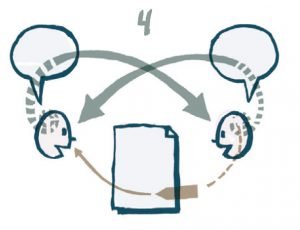Visual Feedback: A Second Channel of Communication
Courtesy of bikablo
During discussions with colleagues or clients, you may sometimes get the feeling that there is a lack of mutual understanding, to create clarity all you really need is: a pen, a piece of paper, and a couple of drawing basics. With these tools, visualization opens a second channel of communication, and immediately, people begin to better understand each other's point of view.
How thoughts are "anchored" in the brain.
Back in 1971, Allan Paivio, a native Canadian, introduced his Dual Coding Theory at the University of Western Ontario. His theory was based upon the assumption that, since we mentally process images differently than we do verbal or written information, we learn more easily when we can also imagine information in terms of images. If we're learning a foreign language, for instance, and trying to memorize a word like “Hund,” the German word for “dog,” if we imagine a scruffy dog at the same time, our brain then will create two different “representations,” as Paivio has termed them, for a single piece of information. When we later try to recall this learned piece of information back into memory, we can activate both of the information channels, and this allows us to recall the information more quickly.
We employ this theory at the bikablo akademie as well, when, in our discussions with others, we translate ideas, aspects, and details into small sketchnotes, consisting of text and images. We refer to these as “thought sketches” or “sketchnoting in dialogue.” When we do this, the following happens:
Step 1
When we talk, everyone formulates their thoughts. I hear what my counterpart is saying - but am I imagining the same thing? have I really understood him?
Step 2
If, in parallel, I draw what I have heard on a sheet of paper, I illustrate to my interlocutor what I have understood from his execution - and offer him insight into my own ideas. In this way, I actively open up the "second channel of perception" that Paivio also talks about.
Step 3
My interlocutor can respond to this input. What does he like about my interpretation, what doesn't he like? What did he perhaps mean differently?
Step 4
Finally, my counterpart can also take up a pen and draw his or her own ideas and conception of the situation. "Thought maps" are created, which can lead to a reflected solution in further conversation. In this way we come to a common understanding and can cultivate a deeper and inspired exchange.
Sketchnoting a conversation - just give it a try!
For your next meeting with a colleague, put out paper and pens and try to capture ideas together using small pictures or visual notes. To sketchnote effectively in a conversation, you really only need a few simple visual concepts. And don't worry - they're just sketch notes! Nothing can go wrong.
Do you see the potential in visual feedback and want to learn the fundamentals of visualization? Check our my courses page for upcoming visualization trainings.






